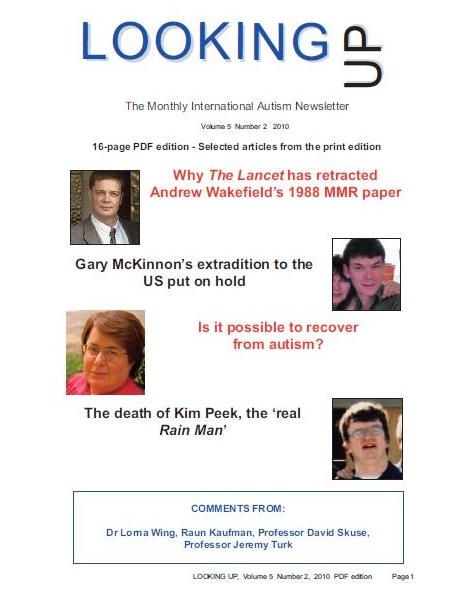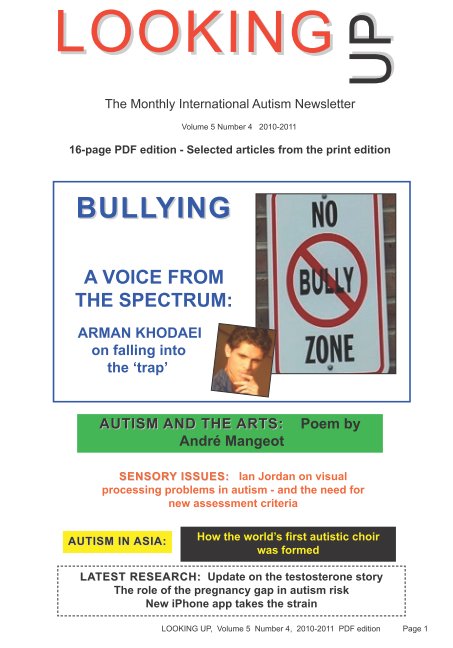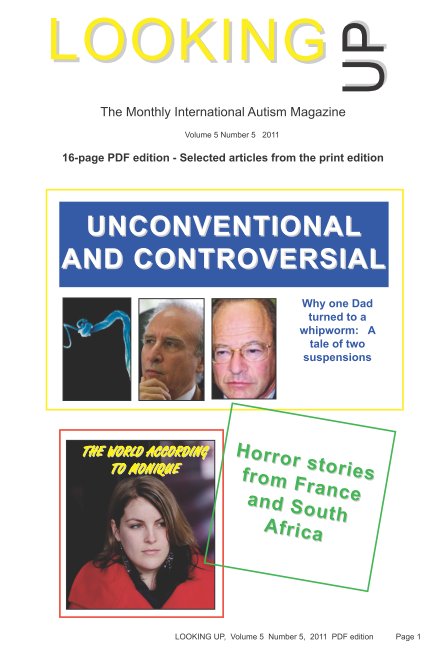Looking Up, 16-page English PDF Edition, Back Issues and Current Issue

|

|

|

|

|

|

|

|
| Home page | Subscribe (print edition) | Selected articles | Our publications | Our mailing lists |
| PDF edition | Subscribe (PDF edition) | Back issue contents | Autism books | Contact us |
From Volume 3 Number 10
One
of the world’s leading experts on Asperger’s syndrome, DIGBY TANTAM -
professor
of psychotherapy and co-director of the Centre for the Study of
Conflict and
Reconciliation, based at the University of Sheffield, UK - spoke to
ADAM
FEINSTEIN: I have often felt that
there
is a difference between Asperger’s syndrome and high-functioning
autism: namely
that people with Asperger’s generally crave friendship and are pained
when they
are unable to achieve this, whereas people with HFA do not have this
same
social drive. Have you found this?
DIGBY TANTAM: The first thing to be said is that there is no difference, in principle, between autistic disorder and Asperger’s syndrome. Lots of studies have shown that there is considerable overlap. Clearly, in some general way, people with Asperger's syndrome are less severely affected, but it is really hard even to specify that. If you are going to restrict autistic disorder to people with a generalised learning difficulty, or people with significant language problems over and above their autistic impairment, as the diagnostic manuals say, then you can divide people into two groups. But it is an arbitrary division. In Britain, what has happened is that people use Asperger’s syndrome in a much more functional way. Essentially, they use it, I think, for people who are self-aware. The big thing about people with Asperger’s syndrome is that they are aware of themselves and their situation and they make demands on the world, like everyone else. People with autistic disorders in the low-functioning group tend not to be self-aware. And as a result, they go along with whatever their carers provide to them. That, of course, is challenging, because they can be exploited, but in another way, the old traditional model of mental handicap services applies quite well to them. They can be looked after by people who are kindly disposed. Now, on the dimension of sociability which you mentioned: I think there are people with autistic disorders who are sociable, as there are people with Asperger’s syndrome who are unsociable. This depends on all sorts of factors, including temperament and social experience. But it is true to say that some people with autistic disorder in the low-functioning and non-self-aware group will not necessarily say to themselves: “Other people I know have friends, but I don’t. What’s going wrong?” The big difference with people with Asperger’s syndrome is that, because they are self-aware, they are also aware of other people and aware of what other people have and they don’t have. They make comparisons and experience pain and dissatisfaction as a consequence of that. So I think there is a different attitude to friendship, but not necessarily a difference in sociability.
AF:
I have found that, when it comes to
obsessions, a lot of people with a diagnosis of autism who are
high-functioning
still have obsessions with objects (for example Ros Blackburn, with her
flappies - pieces of paper), whereas people with a diagnosis of
Asperger’s tend
to be obsessed with talking about objects (like light bulbs) rather
than a
sensory attachment, or with a topic of interest.
DT: When I wrote my PhD thesis, I did look at the content of special interests in relation to IQ and it actually seemed to be a question of IQ or cognitive complexity, to a large degree. People who have a high level of cognitive complexity are much more interested in abstractions than they are in concrete things. Not always, but often. So I do not think that the nature of special interests itself maps directly on to the autism-Asperger division - although as it is a division linked to intelligence, it does exist. But of course, people with quite severe autism can be fascinated by numbers. They can be calendrical calculators.
AF:
On the language issue, I wondered what your
reaction was to Pat Howlin’s 2003 study showing that individuals with
Asperger’s also performed poorly on language tests. This finding seemed
to
challenge the assumption that early language development is normal in
people
with Asperger’s.
DT: Hans Asperger himself said that pronominal reversal was common in people with Asperger’s syndrome. I think there has been a general recognition that language cannot be as simply pinned down as people thought. Their social, pragmatic use of language has long been known to be abnormal. I haven’t read that particular paper. I personally believe that there is, in some people with autistic disorder, a kind of dysphasia - a specific disorder of language which is not present in people with Asperger’s syndrome.
AF:
Could Pat Howlin’s study make the linguistic
distinction invalid?
DT: The distinction is the one that the parents and carers make - a functional distinction. As we know, it can be very dispiriting for people with Asperger’s syndrome to be given a residential placing where everyone else has a lower-functioning level of autism. Similarly, putting somebody with a lower- functioning level of autism into an environment where you expect the same from them as someone with Asperger’s syndrome is counterproductive. So, whatever the difficulties in classification, there clearly is a functional difference.
AF:
What is your view on the suggestion that
there could be a neurological difference between the two conditions:
namely, a
left- and right-hemisphere difference?
DT: There was a time when neurologists said that Asperger’s was a right-hemisphere disorder. I think it was Antonio Damasio who pointed out that people with right-hemisphere strokes had a condition called aprosodia, which is very like Asperger’s syndrome. The neuro-imaging does not really support the idea that there is a specific abnormality in either hemisphere, and actually suggests that it is the linking up of the two hemispheres which is the important aspect. There is evidence of abnormalities in speech- and language processing in people with autism and that is usually located in the dominant hemisphere. I don’t think it is going to be down to a specific lesion in either hemisphere of the brain. It will be about how the brain links up. Very little is known about the right hemisphere.

|

|

|

|

|

|

|

|
| Current 40-page print edition issue | |||||||||||||||
|---|---|---|---|---|---|---|---|---|---|---|---|---|---|---|---|

|
| ||||||||||||||
| PRINT EDITION BACK ISSUE CONTENTS AND FRONT COVERS | ||||||||||||||||||||||||||
|---|---|---|---|---|---|---|---|---|---|---|---|---|---|---|---|---|---|---|---|---|---|---|---|---|---|---|
| VOLUME 1, Number: | 1 | 2 | 3 | 4 | 5 | 6 | 7 | 8 | 9 | 10 | 11 | 12 | VOLUME 2, Number: | 1 | 2 | 3 | 4 | 5 | 6 | 7 | 8 | 9 | 10 | 11 | 12 | |
| VOLUME 3, Number: | 1 | 2 | 3 | 4 | 5 | 6 | 7 | 8 | 9 | 10 | 11 | 12 | VOLUME 4, Number: | 1 | 2 | 3 | 4 | 5 | 6 | 7 | 8 | 9 | 10 | 11 | 12 | |
| VOLUME 5, Number: | 1 | 2 | 3 | 4 | 5 | 6 | 7 | 8 | ||||||||||||||||||
| You can find our PDF EDITION CONTENTS AND COVERS on our PDF EDITION BACK ISSUES PAGE | ||||||||||||||||||||||||||
| Home page | Subscribe (print edition) | Selected articles | Our publications | Our mailing lists |
| PDF edition | Subscribe (PDF edition) | Back issue contents | Autism books | Contact us |